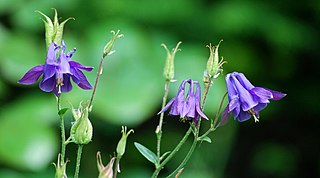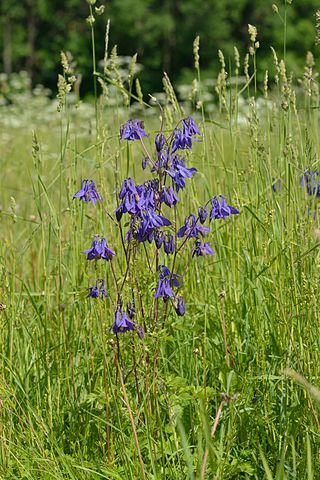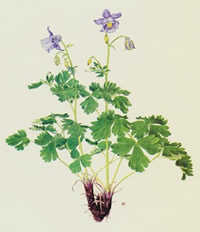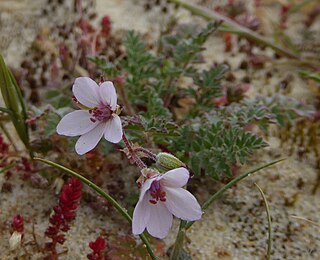
Aquilegia is a genus of about 130 species of perennial plants that are found in meadows, woodlands, and at higher elevations throughout the Northern Hemisphere, known for the spurred petals of their flowers.

Aquilegia vulgaris is a species of columbine native to Europe with common names that include: European columbine, common columbine, granny's nightcap, and granny's bonnet. It is a flowering herbaceous perennial plant growing to 1.2 m tall, with branched, thinly hairy stems. The leaves are biternate; each leaf has three groups of three leaflets. The flowers, in various shades of purple, blue, pink and white, are pendent or horizontal with strongly hooked spurs, and appear in early summer.

Aquilegia nuragica, commonly called Nuragica columbine, is a perennial flowering plant in the family Ranunculaceae. It is endemic to Italy, in a single canyon in the Supramonte mountain range on the island of Sardinia.

Aquilegia atrata, the dark columbine, is a perennial species of flowering plant in the family Ranunculaceae, native to the Alps and Apennine Mountains.

Aquilegia olympica is a perennial flowering plant in the family Ranunculaceae, native to Turkey, Iran, and the Caucasus.

Aquilegia viridiflora, commonly known as the green columbine or green-flowered columbine, is a perennial flowering plant in the family Ranunculaceae, native to southern Siberia, northern China, Mongolia, and Japan.

Aquilegia ottonis is a perennial flowering plant in the family Ranunculaceae, endemic to Greece.

Aquilegia sibirica, the Siberian columbine, is a species of flowering plant in the family Ranunculaceae native to the north-central Asian regions of Siberia, northern Mongolia, Kazakhstan, and Xinjiang. A hardy perennial plant, it prefers temperate environments. The Siberian columbine can be between 1 foot (0.30 m) and 2 feet (0.61 m) tall with flowers that are lilac-blue and white in color.

Aquilegia bernardii, common name Bernard's columbine, is a perennial species of flowering plant in the family Ranunculaceae, endemic to Corsica.

Aquilegia desertorum, the desert columbine, is a perennial species of flowering plant in the family Ranunculaceae, native to the Southwestern United States.
Aquilegia litardierei is a perennial species of plant in the family Ranunculaceae, endemic to Corsica.

Erodium lebelii, sticky stork's-bill, is an annual plant in the family Geraniaceae. It occurs on sand dunes and heaths on the Atlantic and Mediterranean coasts of western Europe. Its taxonomic status is uncertain: some authorities consider it merely a variety or subspecies of common stork's-bill while others consider it to be the same as the north African species Erodium aethiopicum.

Aquilegia amaliae, common name Amalia's columbine, is a perennial species of plant in the family Ranunculaceae, native to the southern Balkans.
Aquilegia apuana is a perennial flowering plant in the family Ranunculaceae, endemic to central Italy.
Aquilegia ballii is a perennial flowering plant in the family Ranunculaceae, endemic to Morocco.

Aquilegia barykinae is a perennial flowering plant in the family Ranunculaceae, endemic to the Russian Far East. The species was first described in 2014. Its flowers are lilac-blue.
Aquilegia borodinii is a perennial flowering plant in the family Ranunculaceae, native to Siberia and Mongolia.
Aquilegia chitralensis is a perennial flowering plant in the family Ranunculaceae, endemic to Pakistan.

Aquilegia cossoniana is a perennial flowering plant in the family Ranunculaceae, native to the Atlas Mountains in northwestern Africa.
Aquilegia dichroa is a perennial flowering plant in the family Ranunculaceae, native to Portugal and northwestern Spain.















